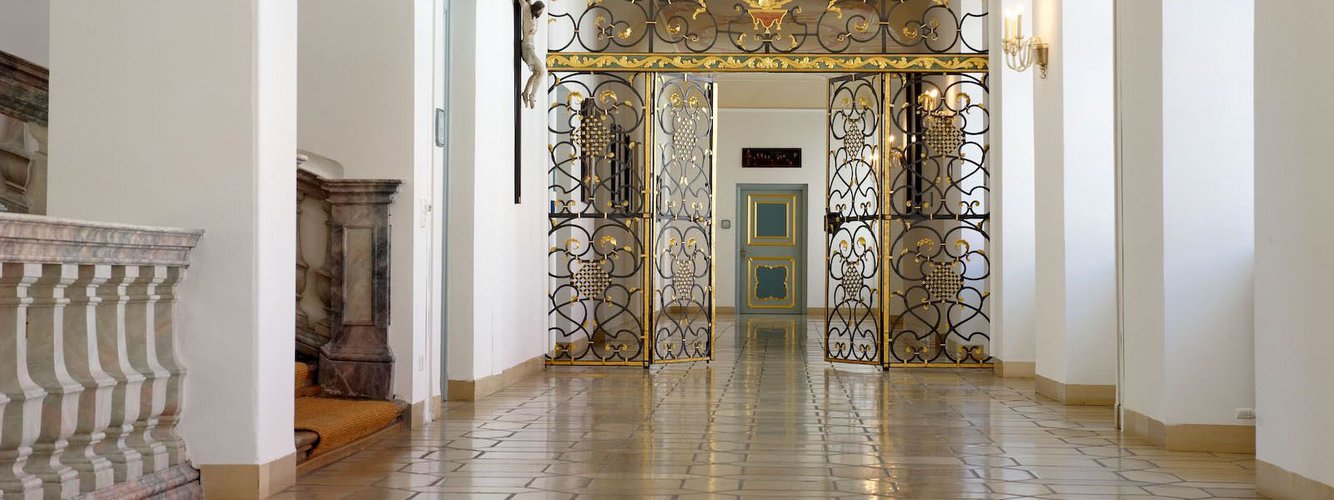

Irsee Monastery: days of light
One who leaves the Wertach Valley north of the ancient, free, imperial city of Kaufbeuren and travels through a forest depression up one of the many glacial drifts from the Ice Age in this area suddenly gains a view of a magnificent baroque complex: Irsee Monastery.
A mighty, towering building complex, a blocking bastion, initially elevates itself in the valley cutting. However, this wing soon dissolves and one’s gaze follows, relieved, the delicately shaped towers, which break through the high horizon above the baroque collegiate church like scissor cuts in an abundance of forms. The arch of cantilevered red roofs above the former abbey complex from the beginning of the 18th century dominates a harmoniously structured building, divided into sections by wide risalits.
One then notices the rhythm of the many windows, which break through the facades in a three-storey series. Only from close up does one realise that some of the windows are only painted in order to preserve the symmetry. Trompe l'oeil – the principle of baroque architecture and painting, harmony as a product of the beautiful appearance or as an effect of mystical numerical ratios? Three floors above the rectangle of the building complex, which groups around a closed inner courtyard. According to ancient symbolism, heavenly and earthly meet in the numbers three and four. Irsee as the concave mirror of cosmic order. The visitor, who enters through the western portal, moves around, unconsciously, in a micro cosmos where forces of heaven and earth combine to become a dense form. Can one not feel it? Are there places where the forming forces of the human mind particularly like to combine because they take form more easily there?
When one enters the Swabian Educational Centre today, which the district assembly of Swabia set up under its culturally aware and dedicated president Dr Georg Simnacher between 1974 and 1981 in the walls of the Benedictine abbey Irsee Monastery – secularised since 1803 – one would almost like to think that the "genius loci" is also here in a forest valley of the East Allgäu. Besides liturgical prayer and clever business, science and education were important focuses in the life of the Irsee monks. In addition to philosophy and music, the sciences in particular found renowned representatives in the 18th century among the members of the Irsee convent. Names such as Ulrich Weiß, Candidus Wehrle, Ulrich Peutinger, Eugen Dobler and Meinrad Spieß stand out from the community of padres.
Little wonder that after 200 years this spirit returns to the former monasterial buildings and finds an adequate home again in a magnificent atmosphere after a long misuse. However, in modern dimensions. While a maximum of 25 monks lived in the abbey in the 18th century, the Swabian Educational Centre houses approximately 20,000 overnight-stay guests per year. 15 expansive, modernly equipped conference rooms - from the festal hall to the intimate group or meeting room - approximately 100 beds and a kitchen for the restaurant make each conference a festal experience. The atmosphere of informal merriment and calm concentration is appreciated by conference organisers, their trainers and participants alike.
Whether one wants to be or not – one is fascinated and captivated by the delicate colourfulness, the charming stucco ornamentation in the light-flooded staircases and corridors, in the carefully restored function rooms such as the library hall, the reception room and the chapter house. The guest also has air to breathe and space to move everywhere here. The entrance staircase is a magnificent overture with its overwhelming baroque scenery – a gem of Wessobrunn stuccoer Franz Schmutzer, created from 1727 - 1729 under the ceiling painting of Franz Anton Erler from 1730 - 1735.
Prominent guests from the fields of politics, business and above all science have been guests here since the restoration of the Swabian Educational Centre. Two large event organisers make particularly intensive use of this jewel among the Bavarian educational centres: Swabian Academy, launched by the district of Swabia and the Swabian adult education centres, and the Training Institute of the Bavarian District Assembly.
While the Swabian Academy focuses on adult education with the subject fields of anthropology and cultural history as well as on creative art and music, the Training Institute devotes itself to further education in the fields of social studies and psychiatric care in Bavaria.
The latter is also, to an extent, reparation in Irsee. The henchmen of the murderous euthanasia during the Nazi regime found their victims at the Kaufbeuren Curative and Nursing Institute, of whose domain Irsee was part. These were probably the darkest hours of the former abbey, which, during its history, was also affected by the chaos and catastrophes of the peasants’ wars, the 30 Years’ War and the Secularisation.
The commemoration of the past is part of the future, for example when one sits in the magnificent white-arched hall of the old minster and casts one’s glance from Balthasar Freiwiß’s flaming organ front to the famous ship pulpit, to the dark church paintings of padre Magnus Remy to the jewel-decorated relics of the Christian martyrs on the altars. What chance does the tradition of Occidental-Christian education have against murderous brutality and destruction, against the continuously recurring horrors of history? It creates the new beginning and the awakening to humanity – it shows the possibilities of man in the highest and most beautiful perfection. That is why Irsee is so important.
Dr. Rainer Jehl
1984 – 2009 Director of the Swabian Academy